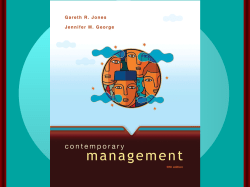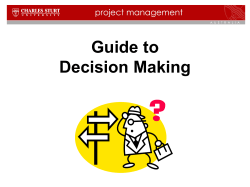
Decision Making
Decision Making Outline • • • • • • Definitions Decisions and alternatives Characterizing decisions Decision making strategies Decision making phases Implications for decision support Definitions • Choice about a “course of action” -- Simon • Choice leading to “a certain desired objective” -- Churchman • Knowledge indicating the nature of a commitment to action -- Holsapple and Whinston Simon’s Model of Problem Solving • Decision-making consists of three major phases---intelligence, design, and choice [Simon] • H.A. Simon. 1960. The New Science of Management Decision. Harper and Row, NY. • Newell, A., & Simon, H.A. (1972). Human Problem Solving. Prentice-Hall, Englewood Cliffs, NJ. Example A farmer with his wolf, goat, and cabbage come to the edge of a river they wish to cross. There is a boat at the river’s edge, but of course, only the farmer can row. The boat can only handle one animal/item in addition to the farmer. If the wolf is ever left alone with the goat, the wolf will eat the goat. If the goat is left alone with the cabbage, the goat will eat the cabbage. What should the farmer do to get across the river with all his possessions? Phase I: Intelligence – Problem Identification and Definition • What's the problem? • Why is it a problem? • Whose problem is it? Phase II: Design – Problem Structuring • Generate alternatives • Set criteria and objectives • Develop models and scenarios to evaluate alternatives • Solve models to evaluate alternatives Problem Solving • State Space Search – Initial State – Goal State – Operators • Choosing representation and controlling the application of operators requires decision making Problem Representation L R States and Operators • State = <Farmer/Boat location, Wolf location, Goat location, Cabbage location> • Operator • <L,L,L,L> ----> <R,R,L,R> • ….. Phase III: Choice – Solution • Determine the outcome of chosen alternatives • Select the/an outcome consistent with the decision strategy Decisions and Alternatives • Alternatives • where do they come from? • how many are enough? • Evaluation • how should each alternative be evaluated? • how reliable is our expectation about the impact of an alternative? • Choice • What strategy will be used to arrive at a choice? • E.g., DxPlain Human Cognitive Limitations (Harrison, 1995) • Retain only limited information in short-term memory • Display different types and degrees of intelligence • Those who embrace closed belief systems restrict information search • Propensity for risk varies • Level of aspiration positively correlated to desire for information Common Perceptual Blocks (Clemen, 1991) • Difficulty in isolating a problem • Delimiting the problem space too closely • Inability to see the problem from various perspectives • Stereotyping • Cognitive saturation or overload Decision Making Strategies • Strategies: – Optimizing – Satisficing – Quasi-satisficing – Sole decision rule – Selection by elimination – Incrementalism and muddling through Decision Making Strategies • Considerations – Individual-focused vs. organization-focused decisions – Individual vs. group decisions – Expensive-to-change vs. inexpensive-tochange decisions Optimizing • Goal: select the course of action with the highest payoff – estimation of costs and benefits of every viable course of action – simultaneous or joint comparison of costs and benefits of all alternatives – high information processing load on humans • people do not have the ``wits to maximize'' [Simon] Observations • Given high cost in time, effort, and money • Decisions are made under severe time pressure (``fighting fires'') • Optimization on stated objectives may result in sub-optimization on unstated, less tangible objectives • Therefore, people often – Do not consider all alternatives – Do not evaluate all alternatives thoroughly and rigorously – Do not consider all objectives and criteria • Place more weight on intangible objectives and criteria Satisficing • Decision-makers satisfice rather than maximize [Simon]. They choose courses of action that are ``good enough''---that meet a certain minimal set of requirements – Theory of bounded rationality: human beings have limited information processing capabilities – Optimization may not be practical, particularly in a multi-objective problem, yet knowing the optimal solution for each objective and under various scenarios can provide insight to make a good satisficing choice Sole Decision Rule • ``Tell a qualified expert about your problem and do whatever he (she) says---that will be good enough'' [Janis and Mann] • Rely upon a single formula as the sole decision rule • Use only one criterion for a suitable choice – e.g., do nothing that may be good for the enemy • Impulsive decision-making usually falls under this category Selection by Elimination • Eliminate alternatives that do not meet the most important criterion (screening; elimination by aspects) • Repeat process for the next important criterion, and so on • Decision-making becomes a sequential narrowing down process Selection by Elimination • ``Better'' alternatives might be eliminated early on---improper weights assigned to criteria • Decision-maker might run out of alternatives • For complex problems, this process might still leave decision maker with large number of alternatives Incrementalism • Often, decision-makers have no real awareness of arriving at a new policy or decision – decision-making is an ongoing process – the satisficing criteria themselves might change over time • Make incremental improvements over current situation and aim to reach an optimal situation over time • Useful for ``fire-fighting'' situations • Frequently found in pluralistic societies and organizations Heuristics and Biases • Heuristics are “rules of thumb” that can make a search process more efficient. • Most common biases in the use of heuristics – Availability – Adjustment and anchoring – Representativeness – Motivational • A. Tversky and D. Kahneman. 1974. “Judgement Under Uncertainty: Heuristics and Biases.” Science, 185:1124-31 Example 1 •Which is riskier (probability of serious accident): a. Driving a car on a 400 mile trip? b. Flying on a 400 mile commercial airline flight? Example 2 •Are there more words in the English language a. that start with the letter r ? b. for which r is the third letter? Availability • “what is easily recalled must be more likely” • Inability to accurately assess the probability of a particular event happening – Assess based on past experience which may not be representative – Structured review and analysis of objective data can reduce availability bias Example 1 • A newly hired programmer for a software firm in Pittsburgh has two years experience and good qualifications. When an employee at Au Bon Pain was asked to estimate the starting salary she guessed $40,000. What is your estimate? a. $30,000 - $50,000? b. $50,000 - $70,000? c. $70,000 - $90,000? Example 2 • A newly hired programmer for a software firm in Pittsburgh has two years experience and good qualifications. When an employee at Au Bon Pain was asked to estimate the starting salary she guessed $80,000. What is your estimate? a. $30,000 - $50,000? b. $50,000 - $70,000? c. $70,000 - $90,000? Adjustment and Anchoring • Make estimates by choosing an initial value and then adjusting this starting point up or down until a final estimate is obtained – Most subjectively derived probability distributions are too narrow and fail to estimate the true variance of the event – Assess a set of values, instead of just the mean Example What is the most likely sequence of gender for series of children born within a family? - The sequence of BBGGBG, BGBBBG, BBBBGG? Example •Mike is finishing his CMU MMM degree. He is very interested in the arts and at one time considered a career as a musician. Is Mark more likely to take a job: a. In the management of the arts? b. A medical management position? Representativeness • Attempt to ascertain the probability that a person or object belongs to a particular group or class by the degree to which characteristics of that person or object conform to a stereotypical perception of members of that group or class. The closer the similarity between the two, the higher is the estimated probability of association – Small sample size bias – Failure to recognize regression to the mean (predicted outcomes representative of the input?) Motivational • Incentives, real or perceived, often lead to probability estimates that do not accurately reflect his or her true beliefs – Non-cognitive, motivational biases – Difficult to address through the design of a DSS • Solicit a number of estimates from similar sources, both related and unrelated to problem context Summary: Heuristics and Biases • Heuristics are rules of thumb that we use to simplify decision making. • Overall, heuristics result in good decisions. On average any loss in quality of decision is outweighed by the time saved. • But, heuristics can cause biases and systematic errors in decision making when they fail. • In addition, we are typically unaware of the heuristics and biases, and fail to distinguish between situations in which their use is more and less appropriate. Evaluation Metrics • Effectiveness: what should be done – Easier access to relevant information – Faster, more efficient problem recognition and identification – Easier access to computing tools and models – Greater ability to generate and evaluate large set of alternatives • Efficiency: how should it be done – Reduction in decision costs – Reduction in decision time for same level of detail in the analysis – Better quality feedback Implications for Decision Support • Different people will use different strategies at different times for different kinds of decisions – Which decision strategy to engineer in a decision support system? – Multiple strategies may be used in making a decision Implications for Decision Support • Is there an ``optimal decision strategy’’ for each problem? – What are the information processing requirements for each decision-making strategy? – Which strategy do decision-makers favor, When, and Why? Value of DSS • Increase the bounds of rationality – easier access to information – identify relevant information – increase ability to process information
© Copyright 2025





















